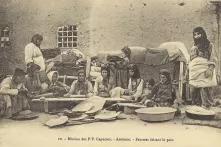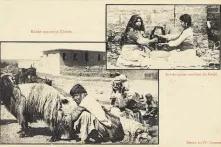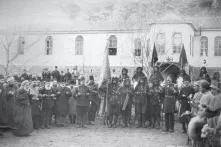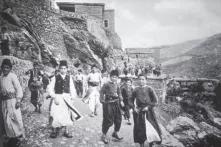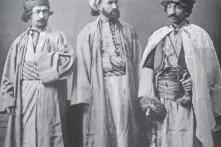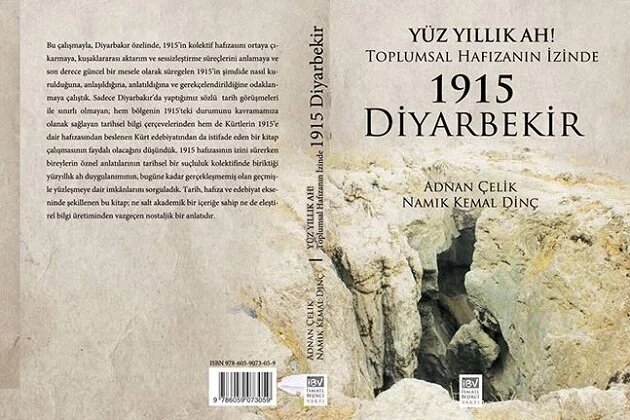
An important center of the Armenian genocide was Diyarbakır. Both the urban Armenian population and the convoys passing through the city were massacred. In their study One Hundred Years of Sorrow - On the Track of Social Memory: 1915 Diyarbakır, (“Yüzyıllık Ah! – Toplumsal Hafızanın İzinde: 1915 Diyarbekir”) published by the İsmail Beşikçi Foundation, Adnan Çelik and Namık Kemal Dinç searched for the specter of genocide haunting the city by drawing on intergenerational transmissions, political facts and the reflections of the genocide in Kurdish literature.
Are you both from Diyarbakır? Have you run across any traces of 1915 in places you were born and lived?
Namık Kemal Dinç: I am from Erzincan and Adnan is from Diyarbakır. 1915 was experienced somewhat differently in Erzincan and Diyarbakır, and there are also differences
in the ways in which it was subsequently remembered. The Armenian population in Erzincan was dramatically exterminated, but both cities can be regarded as Armenian cities. Especially in Diyarbakır, Armenian people had very serious influence on urban life and culture. Their number was also high.
You say in your book that there were sixty thousand Armenians living in Diyarbakır…
Dinç: We came to this conclusion by drawing on other sources; otherwise there are very different figures. The Armenian population comprised 25-30% of the whole population in the city, which is not an insignificant statistic. In his travelogue the Seyâhatnâme, Evliya Çelebi said that Diyarbakır is also an Armenian city. According to him, as plenty of Armenians were settled there and left their mark on the culture, art, music, life styles and commerce of the city, it is an Armenian city. Our study also shows very clearly that this abundance of Islamized Armenians has introduced another history whose effects are still with us today. There are plenty of Armenian people remaining within the tribes in Diyarbakır. As for Erzincan, for example in our village, people spoke of two to three Armenian women. It is also the same in the neighboring village. There are stories about children seized or hidden by others, but it is impossible to talk about families or men continuing their lives. This is not only about 1915. From 1917-18, that is, from the end of the war, another constellation also surfaced in Erzincan. After the retreat of the Russian army, conflicts were experienced with the remaining Armenians, which led to mutual massacres. Physically speaking, perhaps it was impossible to speak of Armenians in Diyarbakır anymore, but Islamized Armenians continued their existence considerably. There are no people in Erzincan who say “I am also an Armenian; we also have an Armenian lineage.” There are some church remnants, some properties left over by Armenians, yet Armenians themselves do not exist there anymore.
Adnan Çelik: Before 1915, approximately 30% of Diyarbakır’s population consisted of non-Muslims like Assyrians, Chaldeans, and particularly Armenians. There were Arabs, Turkmens and Kurds. Especially after the 1990’s, i.e., after the migration from the rural areas to urban centers, and as a consequence of the earlier liquidation of Armenians and non-Muslims, Diyarbakır increasingly became a Kurdish city; with the rise of the Kurdish political movement and especially due to the Diyarbakır Prison, it was transformed into a political capital, a center. Historically speaking, it is indeed a multi-cultural, multi-religious, multi-ethnic city. But unfortunately it lost this character in the wake of 1915.
Has the memory of Armenians been suppressed in Diyarbakır as much as it has been done in Erzincan?
Çelik: It could not and cannot be suppressed, because something always reminds people of Armenians. It is always possible to feel the presence of Armenians in districts and villages. Why do people of Diyarbakır and Kurds remember the Armenian genocide so vividly? Extreme forms of violence were implemented during the genocide. This violence has been inscribed into the bodies, hearts and memories of people. It is still traumatic; that people have not been able to forget these violence narratives.
Some of your interviewees talked with ease about the 1990’s, about the atrocities they went through. However, when it comes to the Armenian genocide, they wanted to turn off the tape recorder. They had difficulties while talking…
Çelik: Yes, it is difficult to talk about it, but it is perhaps something inexpressible. However, when one refers to the past practices of violence, the seriousness and the scale of the situation becomes apparent. The majority of Armenian convoys brought from the north during the genocide passed through Diyarbakır and Mardin. Many killings were perpetrated in the province of Diyarbakır. Some places where people were killed are now associated with this slaughter. The memories of these places had a great impact upon people.
These are desolate places, aren’t they? Straits, rivers, caves…
Çelik: These are places out of sight. Places where it is possible to rapidly and easily make the bodies of killed people disappear. Chasms, caves, pits, straits, cisterns… There were many Armenians in Diyarbakır who were able to survive. Some of them were Islamized and some of them continued their daily existence in their own religion. We know that until the 1960’s and 1970’s 10 to 20 families lived in Lice, Silvan and Kulp making their living from various crafts. All these dynamics enabled this memory to be brought into the present and kept them always alive.
And some of your interviewees paint a very positive picture about the mutual life of Kurds and Armenians before 1915. For instance, the starting point of the book is the institution of “kirve.” Is this a sort of emotional atonement or does it correspond to reality or do people just wish for it to be so?
Dinç: It is true that the relation between Kurds and Armenians started to deteriorate from the beginning of the nineteenth century. It was thought that Tanzimat policies were in favor of Armenians and against Kurds. Generally speaking, Tanzimat policies called for equality, but Muslims were discontented because they were losing their privileges and witnessing the loss of their sovereignty. The Ottoman state’s aim was to hold together different people with these policies of equality.
It is said that the corrosion of Kurdish unity after the suppression of the Bedirhan Revolt had also its share in this situation. Is this true?
Dinç: But we also know that Bedirhan perpetrated two major massacres against Nestorian Christians. When the rebellion was suppressed and Bedirhan was arrested by the Ottoman state in 1847, the Armenian-Greek Patriarch in Istanbul published an announcement addressing all Armenians. He put the Ottoman sultan Abdulmecit on a pedestal and said, “You have saved us from these savage Kurds by vanquishing Bedirhan”. But these peoples lived together in the same land for over 3000 years. It is stated in many genocide narratives that one could not even distinguish these peoples by their clothes; we know that local people were asked to identify Armenians. They often could speak each other’s languages. Of course, there were some periods of disappointment or resentment, but they lived together in the same villages, and more importantly, they had established a mutual economic life.
Let’s say an Armenian village pays a tax to Istanbul, but also pays another to the Kurdish bey under the name of protection. What kind of an economic cooperation is this?
Dinç: This double taxation appeared after the Tanzimat. Prior to that, the state did not receive any tax from them. The tax was taken through Kurdish beys, who took their own share and if he had to pay any tax, he gave it to the state. Over 400 hundred years of Ottoman rule, Kurds had some privileges. Some rights were accorded to them in a context one might call autonomy. The Ottoman state was certainly an external force. It was established only in urban centers. Even if you take the periphery of Diyarbakır as an example, the Kurdish bey in Silvan was much more influential and stronger than the official of the Ottoman state. Major Noel made observations about this. He makes a remark about the economic relations between Kurds and Armenians: “Kurdish is a widespread language. And Kurds are not the murderers of Armenians. They saved Armenians from the hands of Turks many times.” In other works, he says: “In economic terms, Armenians cannot survive without Kurds.” This statement is from 1919. One of the reasons for the continued existence of ten families in towns was to maintain this economic life. The economic life of Kurds thus received a severe blow with the departure of Armenians. Kurds were partly engaged in animal husbandry and partly in agriculture. And Armenians were engaged in agriculture, artisanship, trades, etc. As a matter of fact, the relationship between them is one of mutual benefit. So why were Armenians good at artisanship and trades? It is because Kurds and other Muslim elements were seen as a combat force. They often went to wars and did not come back. However, as Christians were not recruited, Armenians could subsist on these jobs. They were also imposed to pay a heavy tax called jizya. Every man above the age of 12-13 had to pay jizya, which was also phrased as the head tax. But how could they pay it? By earning income. Therefore, they had motivation to excel not only in agriculture but also in trades and artisanship.
What is the meaning of the Bedirhan tribe for the unity of Kurds? Is it the case that a dissolution appeared among Kurds after them and this dissolution was concretized in the form of harassment of Armenian villages?
Dinç: There was no Bedirhan tribe, but a “beylik”. Tribes are composed of sub-units. A beylik is a structure above the confederations of tribes. There was certainly a dissolution in this period. Apart from Bedirhan, there were some beyliks in Van, Muş, Bitlis, Diyarbakır and Ağrı. The Beylik of Doğubeyazıt was a very famous one. There were lots of beys in Erzincan. All these beyliks were terminated in 1848. Their lands were confiscated; and if any agreement was negotiated, some part of the incomes obtained from the land were assigned to them as a salary. Otherwise, as was the case for the Bedirhan beylik, the state exiled them. It was then impossible for Bedirhans to set foot on their own lands. The power structure was changed along with the land regime and administrative structuring. The state confiscated their lands. In 1858, the Land Code was introduced. Land started to be distributed and taxes were collected through this framework. Just at this period, after the liquidation of beys, Kurdistan was transformed into a geography of sheer chaos. The Ottoman state appointed governors and district governors and there are some reports written by them: “We cannot maintain the administration, we cannot control the tribes, everyone is at odds with everyone…” Beys had established an order there thanks to their authority, but the governors appointed by the state did not have any position to re-establish an order on their own, because the tribes did not recognize their authority. In that period, a new ruling class appeared among Kurds that became an alternative to beys. And these people were religious functionaries, sheikhs and mullahs. From this date onwards, the pioneers of political movements in Kurdistan were sheikhs. The Sheikh Ubeydullah Movement emerged after 1881; Mele Selim in 1914 and Sheikh Said in 1925. These figures came to the fore with their religious authority. On the other hand, the Armenian Regulation was introduced in 1862, which led to the formation of the Armenian Assembly. It had the quality of a constitution. This assembly had members wherever Armenians lived and also had representatives in Kurdistan. As Christian representatives stepped forward in the public realm, Muslim religious representatives and mullahs came to the fore as a response. Another reason for this was that sheikhs appropriated most of the lands following the newly-instituted land code. Sheikhs were also the owners of great land tracts and emerged as major merchants. For example, Sheikh Ubeydullah, who revolted against the state in 1880, was a landowner, having a monopoly on tobacco. Abdulhamid II made the second strategic move. He came to power in 1876 and pursued pan-Islamist politics as a reaction to the Tanzimat policies, espousing a politics oriented towards winning the hearts of Muslims, and by extension Kurds, who felt offended by the Tanzimat. This period was dominated by Kurdish religious functionaries, a period when the pivotal rupture broke out not only for Kurds themselves but also for the relations between Kurds and Armenians. The Russo-Ottoman War of 1877-78 erupted during this period. Article 61 added to the Berlin Treaty stipulated that attacks by Kurds and Circassians against Armenians be prevented and reforms be made in favor of Armenians in six provinces. Here is how this term “reform” was perceived among Kurds: An Armenian state would be established here and Kurds would be slaves to Armenians. This societal tension started to increase in 1878-79 and with the establishment of the Hamidiye Cavalry Regiments, the relationship between Kurds and Armenians were ruined.
The reform proposition for “six provinces” seems somewhat similar to “democratic autonomy,” doesn’t it?
Çelik: If it had been properly implemented, then it would have come close to it. It could have been an attempt trying to create opportunities for different religious and ethnic groups to live together. It is not something as elaborately thought out as the current idea of democratic autonomy, but it is now understood that it was then a relatively democratic concept.
Dinç: Over the course of the nineteenth century, the Ottoman state encountered a similar practice in the lands it had lost. First, they had demanded autonomy, which also included specifications such as a local gendarme force, i.e., the establishment of a local police and defense force. For instance, in Bulgaria, it was first thought that Bulgaria would be divided into three parts with a Western gendarme force to be deployed there as a guarantee. In other words, security shifted onto another hands and the Ottoman state came side by side with other military powers. Their position was to protect Ottoman citizens from the Ottoman state itself. Of course, this had a gradual progression, culminating in independence. Having previously been divided into three parts, Bulgaria then appeared as a single and united entity. And then it dealt the great blow in the Balkan War. The Ottoman state feared a similar possibility regarding the Armenians.
But in fact, the Ottoman state did not want to recognize equality.
Dinç: It certainly did not want to recognize equality. But the Tanzimat period is somewhat different. Laws and edicts enacted in this period were quite progressive, containing theoretical steps to ensure equality. The Reform Edict of 1856 was a continuation of Tanzimat. It enabled Christian elements to be represented in local assemblies and abolished the jizya tax. These were parts of a policy of equality the Tanzimat could not create.
On the other hand, there is 1908, a year witnessing demonstrations with flags and banners in different languages. Albeit temporary, a feeling of fraternity emerged. But a year later Armenians were being massacred in Adana. The Armenian organizations in 1908 were also the first ones espousing socialist ideas. And the populations they represented lived in Eastern Anatolia to a large extent. What is the heritage handed over by these organizations and political demands to the region in question?
Dinç: For sure, there are some differences. In terms of the socialist experience, there are some differences between what was the case a hundred years ago and the following periods. Nonetheless, we know that they had this kind of political affiliation. These are all referred to in the memoirs of Armen Garo (Karekin Pastırmacıyan) and in the writings, speeches and memoirs of Armenians committed to militant organizations in the late nineteenth century. There was the famous raid on the Ottoman Bank (1896). “Westerners should apply pressure upon the Ottomans so that we obtain our rights” summed up their perspective. This is a Narodnik-style armed propaganda, an anarchist style. What was the connection between this method and the people? How organized were they, how strong were the Dashnaks or the Hınchaks? As far as Dr. Reşid was concerned everyone was organized in all villages including women and children.
Çelik: In fact, their organizations were weak. Perhaps it is possible to correlate them with the founding period of the PKK. It might be possible to think that students and intellectuals came together under a perspective of national liberation and integrated the people into this mobilization through armed and political propaganda. They argued that they ultimately did not pursue a separatist politics against the CUP and therefore waged their struggle within the Ottoman framework.
Dinç: 1908 was in fact a spring of freedom. A constitutional monarchy was proclaimed on June 24 and members of the Committee of Union and Progress gradually started to take state power. And after the 31st March Incident and the Raid on the Sublime Porte, they immediately turned to Abdulhamidian policies right from the moment when they grabbed state power. This reaction against difference continued. If you look at Diyarbakır, you could then see a serious social and class transformation. From the second half of the nineteenth century onwards, Muslim urban notables were concentrated at the center of Diyarbakır. Among them were some avaricious people saying “let’s seize the properties of the non-Muslims.” As of 1908, all of them were Unionists. They were engaged in politics and also represented state power. Some of them were mayors, parliamentarians and district governors. Viewed from the local network of the UPC, they expected that this kind of politics would bring personal benefits. According to the Kurdish newspapers in 1908, the greatest problem was the land problem. This was one of the hot topics of debate. Most of the Kurds, especially those tribe members that had joined the rank of Hamidiye cavalries, seized Armenians’ lands and some of the Armenians escaped to Russia. And when the Second Constitutional Monarchy was proclaimed, they came back and said: “Now there is freedom, so we want our lands back.” But Kurds resisted, so they ended up in court. There was a tension line and a new political elite and notables that could potentially exploit the situation. The intersection of central policies and new local power dynamics led them toward a politics excluding the Christians.
On the other hand, there is a new order instituted by the center, the Unionist power, via the governor Dr. Reşit. He harbored positivist inclinations, defining Armenians as microbes that need to be immediately removed from the body. He had also some experiences with the Greek in the Aegean Region…
Çelik: Hamit Bozarslan co-authored a book with Raymond Kévorkian and Vincent Duclert, where they dwell on the politization of the CUP members. They argue that these people envisioned politics within an extremely positivist, completely social Darwinist framework and that one cannot separate the process leading them to genocide from this framework. They imagined politics as an evolutionary battleground and did not feel any ethical inconvenience while eliminating their rivals. Dr. Reşit was, after all, one of the five founding members of the CUP. He had accepted these ideas before coming to Diyarbakır.
Dinç: Dr. Reşit was born in Dagestan and his family came to Anatolia as exiles. He went to the Military School of Medicine. As you know, this was where the CUP was founded. They divided the six provinces into two, planning to deploy a general inspector in three provinces, and another inspector in the other three provinces. Reşit was appointed as an assistant and then later appointed as a governor to Mosul. Talat Paşa sent a telegram to him saying, “We are thinking about appointing you to Diyarbakır.” “No, I’ve just come to Mosul and I don’t want to make another trip,” he replied but they reached an agreement in the end. “If I am to serve there, I have some conditions,” he said, “I want to take the military Circassian unit here to Diyarbakır.” In a telegram he sent to Talat Paşa, he made it crystal clear: “I am on the side of solving this problem in the quickest way possible.” He was someone who believed that every Armenian, even those living in the villages of Diyarbakır, was a committee member, which corresponds to today’s usage of the term “terrorist.” In March 1915, he was appointed to Diyarbakır and came to Diyarbakır from Mosul in late March and early April. And as soon as he came, he started organizing the formation of two commissions, one of which was an investigation commission, inquiring into the current situation. In a sense, he formed public opinion in this way. Second, he launched a militia organization. Led by the Colonel Mustafa Nusret Bey, this organization included all the urban notables from Yasinizade Şevki Bey to Nakıbzades. And they started their operations around April 10. There is not even a month between his arrival and the start of operations.
We can suppose that this organization not only included urban notables, but also extended to tribes, can’t we?
Çelik: Pirinççizade Fevzi Bey, an urban notable, frequently organized trips to Cizre. On the pretext of the Russian threat and the argument that Armenians would transform the region into Armenia and eradicate Muslims, they prepared the people for the genocide. In rural areas, too, there were some actors committed to the Ottoman bureaucracy. Even if they did not have the sovereignty that the aghas and beys used to have, these local actors had organic ties to the bureaucracy, the governor and the urban notables, who were under the direction of the governor. Even though they did not directly participate in the genocide, they played a significant role in its implementation. We know that in some places religious functionaries encouraged people to resort to violence against Armenians by basing their argument on Islam. But we should also note this: During the genocide, there were also some local actors and religious functionaries protecting Armenians, objecting to directives sent from the center. Generally speaking, semi-bureaucratic categories such as aghas, beys and sheikhs had a very serious role in the social organization of the genocide. And another element is the paramilitary Kurdish militias of 1915, that is, the bejiks. As paramilitary elements, the El-Xamsin Unit deployed in Mardin and the Butchers’ Troop in Van took a role in the deportation and slaughter of Armenians. In Diyarbakır, there was another organization called cendirmeyen bejik. With the outbreak of World War I in 1914, all men under the age of 45 were accordingly recruited. Bejiks were selected from those men above the age of 45, who were physically in a good condition, had a high level of physical mobility, knew their own locality well and could collect intelligence there. Especially during the exportation of Armenian convoys, they attacked these convoys, trying to find and kill those Armenians who hid. Today people associate Cendirmeyen bejiks with the temporary village guards of the 1990’s.
As for Diyarbakır, not only the Armenians of Diyarbakır but also the convoys passing through were killed. Is this true?
Çelik: According to the Ottoman census, the number of Armenians living in Diyarbakır before 1915 was around 60.000-65.000. But the governor Dr. Reşit stated in his own telegram that he dealt with 126.000 people. This means that a number of people, corresponding to the whole figure of the Armenian population in Diyarbakır, were “dealt with” from outside, that is, from the deportation convoys coming from the north!
Can we say that the memory of 1915 is more vividly kept alive in Diyarbakır in comparison to the whole of Turkey? The people of Diyarbakır probably know the origins of the wealth of urban notables. They remember it, see places where people were massacred and remember them, too. Can we say that this has been an underlying tragedy throughout Republican history?
Çelik: These factors are the fundamental dynamics enabling this memory to be more vividly kept alive, but no oral historical study has been carried out in other places of Turkey and Kurdistan within the scale that we adopted in our own work, so it is not safe to say that Diyarbakır’s memory is more vivid. Memory is something which can sometimes be silenced and sometimes re-activated. What we feel within the context of Diyarbakır is that the memory intentionally spoken of in this social realm has been enabled in part due to the momentum created by the political discourse of the Kurdish movement. This movement has produced another historical interpretation refuting and disproving the official history thesis. In another historical reading, the Kurdish movement has stated that this is a genocide, a genocide planned by the CUP and in which some local Kurdish actors also participated. One of the main dynamics making it possible for this memory to get collectivized and brought onto the public space is the attitude taken by the Kurdish movement. The Kurdish movement has created a historiography which has made it possible for a series of things to be expressed for the first time, things which have been suppressed, silenced, covered with a veil of denial and not voiced in the public sphere. In our interviews people often made a connection between the violence against Armenians and the violence perpetrated against Kurds. There are even some Kurdish expressions about this: “Em şîv in, hûn paşîv in”, roughly meaning “We are the dinner and you will be the next meal.”
Dinç: At the beginning of this talk, we compared Erzincan and Diyarbakır. There is no such politicization in Erzincan.
There are very vivid accounts in the book: accounts and testimonies about the moments of slaughter, about how the survivors could cope with this situation. These accounts are like a living narrative…
Çelik: First of all, this has to do with the relation between collective memory and culture and identity. There is a very strong correlation between the oral cultural tradition of Kurds and this memory. I remember that until the early 1990’s there was no television in the village, no adult apart from my peers went to school, and that while spending time together for a long time in a single room, people always talked about the past and a story was re-narrated for tens, perhaps hundreds of times. Our current sensibilities, ethical questionings, and the political possibilities of the current moment also influence the way we remember and narrate. The stories narrated by executioners killing Armenians were formerly very famous in Diyarbakır. In coffeehouses and people’s homes, they talked about how many Armenians they had killed. No people we interviewed spoke of this proudly or excitedly, but with embarrassment and sometimes with sheer silence.
Is it possible that this stems from the characteristics of the people you chose or to which you have had access?
Çelik: We wanted to interview a broad spectrum of people. We wanted to have diversity in terms of people’s political affiliations, gender and age. We interviewed people voting for AKP, HÜDA-PAR and HDP; young and old people, and rural and urban people. We also interviewed Hezbollah members. Very interestingly, there are some differentiations with respect to the justification of histories, but there is a similar commonality with their remembrance. People from every family, every kind of social class often have heard or been exposed to these stories.
In the past, the concept of genocide was perhaps not able to be clearly defined and accepted, but when you look today at the same regions, at Shengal, Northern Syria and ISIL, you can get an impression of 1915. Would you agree?
Dinç: While carrying out this study, we were investigating a genocide perpetrated a hundred years ago, searching to find out the ways in which it is being remembered. Just when we started our fieldwork, a genocide was carried out in Shengal. It was the summer of 2014, a period when we wrote some texts and sent them to each other for evaluation. It is sorrowful to write about the Armenian genocide, which leaves a deep impact upon you, but there is also another genocide happening just before your eyes. There are many overlaps between it and what you read and write, it is almost the same and it happens in a region very close by. This was emotionally hard for us.
Çelik: The reason why you study a suffering, a tragedy experienced a hundred years ago is to proliferate opportunities for confronting the past today, and the same suffering, the same tragedy is perpetrated with very similar methods in front of everyone’s eyes. The Armenian genocide was the first “modern” genocide of the 20th century, but it was not the last. From Holocaust to Rwanda and Indonesia, many similar genocides took place. And I am afraid that they continue to take place. The Yazidi genocide in Shengal is just one of most recent examples of this. While dealing with the issue of confronting the past, we need to really reflect upon the kinds of historiographies and politizations leading people to be so insensitive to and deny these sufferings and tragedies. Confronting the past is not only done to accept past suffering. It is also done in order to demand a series of regulations that would create the conditions to prevent another occurrence of such suffering. I am saying this with the particular example of Turkey in mind. Kurds have not been exposed to such a concentrated massacre as was the case for Armenians, but Alevis and Kurds in Turkey have been experiencing the tradition of state violence for over a century. The emergence of a new historiography is necessary in order to avert this. We need to discard the notorious criteria of Turkishness that is seen as the founding ideology of the republic; then we could consititute a new political contract for co-existence together.
One cannot help but remember the concept of “founding partnership,” which is also sometimes voiced by the Kurdish movement itself. But this partnership seems to include 1915 too…
Dinç: The argument that “we founded this republic together” is not an innocent one. It would be best to say “the Turkish republic was founded in 1915.”
